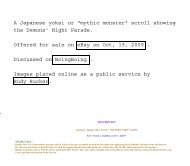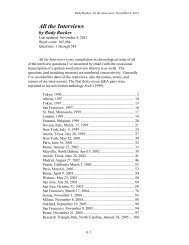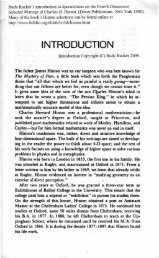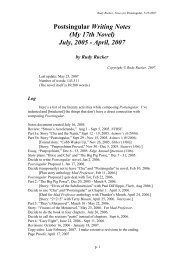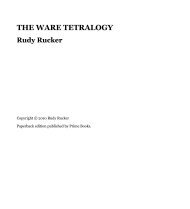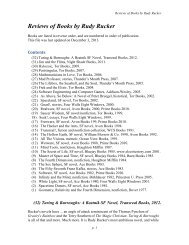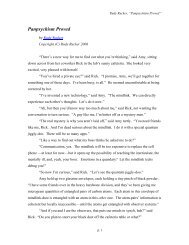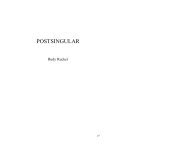Notes for the Lifebox, the Seashell, and the Soul - Rudy Rucker
Notes for the Lifebox, the Seashell, and the Soul - Rudy Rucker
Notes for the Lifebox, the Seashell, and the Soul - Rudy Rucker
You also want an ePaper? Increase the reach of your titles
YUMPU automatically turns print PDFs into web optimized ePapers that Google loves.
<strong>Notes</strong> <strong>for</strong> The <strong>Lifebox</strong>, <strong>the</strong> <strong>Seashell</strong>, <strong>and</strong> <strong>the</strong> <strong>Soul</strong>, by <strong>Rudy</strong> <strong>Rucker</strong><br />
chemistry. He becomes curious about what causes life, <strong>and</strong> he pursues this question by<br />
closely examining how things die <strong>and</strong> decay — <strong>the</strong> idea being that if you can underst<strong>and</strong> how<br />
life leaves matter, you can underst<strong>and</strong> how to put it back in. Victor spends days <strong>and</strong> nights in<br />
"vaults <strong>and</strong> charnel-houses," until finally he believes he has learned how to bring dead flesh<br />
back to life. He sets to work building <strong>the</strong> Frankenstein monster <strong>and</strong> finally reaches his goal:<br />
"It was on a dreary night of November, that I beheld <strong>the</strong><br />
accomplishment of my toils. With an anxiety that almost amounted to<br />
agony, I collected <strong>the</strong> instruments of life around me, that I might<br />
infuse a spark of being into <strong>the</strong> lifeless thing that lay at my feet. It was<br />
already one in <strong>the</strong> morning; <strong>the</strong> rain pattered dismally against <strong>the</strong><br />
panes, <strong>and</strong> my c<strong>and</strong>le was nearly burnt out, when, by <strong>the</strong> glimmer of<br />
<strong>the</strong> half-extinguished light, I saw <strong>the</strong> dull yellow eye of <strong>the</strong> creature<br />
open; it brea<strong>the</strong>d hard, <strong>and</strong> a convulsive motion agitated its limbs...<br />
The beauty of <strong>the</strong> dream vanished, <strong>and</strong> breathless horror <strong>and</strong> disgust<br />
filled my heart."<br />
What writer hasn’t experienced something like <strong>the</strong>se feelings upon seeing <strong>the</strong> work<br />
which he or she ends up writing ⎯ as opposed to <strong>the</strong> original dream!<br />
Architectures<br />
I find it useful to characterize a computing system’s architecture in terms of <strong>the</strong><br />
following two distinctions.<br />
• How many simultaneous processes are taking place, one or many?<br />
• How many different sets of memory are used, one or many?<br />
And in <strong>the</strong> case where <strong>the</strong>re is one shared memory set, we can make a third<br />
distinction.<br />
• If <strong>the</strong>re is only one memory set, is <strong>the</strong> data access of <strong>the</strong> individual process or processes<br />
local or global?<br />
Some of <strong>the</strong> architectures that we’ll be discussing are summarized in <strong>the</strong> table below.<br />
All of <strong>the</strong> cases with many processes <strong>and</strong> many memory sets seem to share <strong>the</strong> same network<br />
architecture as <strong>the</strong> Web, so I’ll just write “network” to describe <strong>the</strong>ir data access.<br />
Example<br />
Number of<br />
Processes<br />
Number of<br />
Memory Sets<br />
Access<br />
To Memory<br />
Turing Machine One One Local<br />
Personal Computer One One Global<br />
Classical Physics Many One Local<br />
The Web Many Many Network<br />
Quantum Mechanics Many Many Network<br />
p. 66




